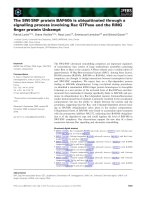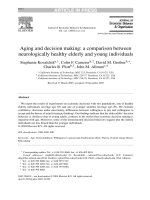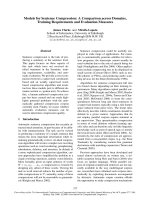Intestinal Fish Parasites as Heavy Metal Bioindicators: A Comparison Between Acanthocephalus lucii (Palaeacanthocephala) and the Zebra Mussel, Dreissena polymorpha pot
Bạn đang xem bản rút gọn của tài liệu. Xem và tải ngay bản đầy đủ của tài liệu tại đây (511.84 KB, 8 trang )
Bull. Environ. Contam. Toxicol. (1997)
59:14-21
©
1997 Springer-Verlag New
York
Inc.
Intestinal Fish Parasites as Heavy
Metal
Bioindicators:
A
Comparison Between Acanthocephalus
lucii
(Palaeacanthocephala) and the Zebra Mussel,
Dreissena
polymorpha
B.
Sues,
1
H.
Taraschewski,
1
M.
Rydlo
2
1
Zoologlsches lnstitut I-Ökologie, Universitat Karlsruhe, 76128 Karlsruhe, Germany
2
Bundesamt für Wasserwirtschaft, lnstitut für Gewässerökologie, Fischereibiologie und
Seenkunde, Scharfling 18, A-5310 Mondsee, Austria
Received: 29 January 1997/Accepted: 7 Apri1
1997
A variety of organisms have been investigated to evaluate their
potential
as biological indicators of different forms of pollution in the
aquatic
environment (e.g. review by Gunkel 1994). Certain species have
been
identified as being highly sensitive either in their physiological
response
to aquatic contaminants or in their ability to accumulate particular
toxins
in a dose-time dependent
manner.
The zebra mussel, Dreissena polymorpha, is generally considered to
be
a reliable bioindicator for passive as well as active biomonitoring and
has
been frequently used to detect heavy metal contamination in
freshwater
ecosystems (e.g. Doherty et al. 1993, Reeders et al. 1993, Stab et
al.
1995). D. polymorpha is well-suited to its role as a bioindicator
because
of its accumulation potential and sessile nature (Stäb et al. 1995),
the
latter feature making it very useful in detecting localized
pollution.
A major source of aquatic metal contamination is road runoff
which
contains a complex mixture of potential toxicants. Maltby et al.
(1995)
described an increase in the sediment and water concentrations of
heavy
metals and identified zinc, cadmium, chromium and lead as the
dominant
metal pollutants derived from motorway runoff. These heavy metals
are
constituents of fuel, brake linings and vehicle tires (Maltby et al. 1995).
A
study by Meisriemler et al. (1990) showed that zebra mussels
collected
from sites receiving road runoff contained higher heavy metal
burdens
than mussels from less polluted
sites.
Recently there has also been an increasing interest in the
relationship
between parasitism and pollution in the aquatic environment as
reflected
in several reviews (e.g. MacKenzie et al. 1995). Extremely
high
concentrations of heavy metals have been found to accumulate in
fish
parasites, principally in adult acanthocephalans but also to a
lesser
degree in adult cestodes (Riggs et al. 1987, Sures et al. 1994a, b,
c,
Sures and Taraschewski 1995, Sures 1996, Sures et al. in press a,
b).
Parasites may offer advantages over currently-used bioindicators
such
Correspondence to: B. Sures
14
15
as D. polymorpha including a more widespread distribution and a
higher
accumulation
potential.
The present study was conducted in a freshwater subalpine lake
in
Austria with localized contamination from motorway runoff. It
compares
the accumulation of lead and cadmium in the mussel Dr e i s s e n
a
po ly mor ph a with that occurring in a common fish species and
its
intestinal acanthocephalan parasite (Acanthocephalus lucii in
close
proximity to the motorway and at a distant reference
site.
MATERIAL AND
METHODS
Ten Perch (Perca fluviatilis) infected with adult Acanthocephalus lucid
and
twelve zebra mussels (Dreissena polymorpha) were sampled from
each
of two sites in Lake Mondsee, Austria. The perch were caught
using
weir-baskets and the mussels were collected by hand from
the
substratum. One sampling site was close to the Salzburg to
Vienna
motorway and received road runoff via a small stream entering the
lake.
The reference site was about 10 km away from the motorway on
the
opposite shore of the
lake.
The fish and mussels were transported alive to the laboratory,
weighed
and measured for length (see Table 1). Samples of muscle, liver
and
intestine were taken from perch with the aid of stainless steel
scissors
and forceps that were cleaned using a 1% ammonium-EDTA
solution.
The acanthocephalans were removed from the fish intestine
and
weighed. All A. lucii found in the intestine of an individual perch
were
pooled and treated as one sample. The zebra mussels were
thoroughly
rinsed with tap water before removing all soft
tissues.
After homogenization of the samples, analytical blanks and
standard
reference material (DORM 1, National Research Council, Canada)
were
digested with nitric acid following a microwave digestion
procedure
described by Sures et al. (1995) and analyzed with a
Perkin-Elmer
4100ZL spectrometer. Metal concentrations were compared
between
tissues and sites using the Mann-Whitney U-test and the
Wilcoxon-test
with a significance level of p < 0.05. Spearman’s rank
correlation
coefficient was used to test for associations between fish length
or
weight and the concentration of lead and cadmium in the parasites
and
the tissues of the fish. Similar associations were tested for the
zebra
mussels.
RESULTS AND
DISCUSSION
The detection limit ( ± 3 SD) was 2.7 ng
ml
-1
for lead and 0.09 ng ml
-1
for
cadmium. Analysis of the standard reference material yielded a
recovery
value of 100 % for lead and 102 % for cadmium. A comparison
between
the amount of lead and cadmium when added either before or
after
digestion revealed that there was no loss of the metals during
the
digestion process (for details see Sures et al. 1995; Sures
1996).
Summary data on the perch, acanthocephalans and D. polymorpha
are
presented in Table 1. Although there were no significant differences
in
the length of perch and the number of A. lucii between sample sites,
the
weight of perch and of parasites was significantly higher at the
reference
site. In contrast, the mean weight and size of zebra mussels
was
significantly higher at the motorway site than the reference
site.
However, despite the smaller size of D. polymorpha at the reference
site
analysis of growth rings on their shells (Neumann et al. 1993)
indicated
that their ages were similar to those from the motorway
site.
Table 1. Size and weight of perch, zebra mussels and weight
and
number of A.
lucii
Table 2. Spearman correlation coefficients (r) and levels of
significance
(p) f o r t h e sign i fica n t rel atio n shi p s b etwee n ho st weight
,
acanthocephalan weight and metal levels in organs of the fish and
the
parasites
16
17
Figure 1. Lead (a) and cadmium (b) concentrations in muscle, liver
and
intestine of perch, its intestinal parasite Acanthocephalus lucii and
in
the zebra mussel Dreissena polymorpha from both sampling
sites
(*: significant
difference).
18
Concentrations of both lead and cadmium (Figure 1) were
significantly
lower in the muscle of perch than in the other fish tissues and in
the
acanthocephalans at each of the sample sites. The highest tissue
metal
burdens were in the liver with mean values between 0.27 - 0.30
mg/kg
for lead and 0.14 - 0.18 mg/kg for cadmium for the two sampling
sites.
These concentrations in the liver differed significantly from other
tissues
only in the case of cadmium. Similar results have been reported
for
perch from other biotopes (Hogstrand et al. 1991, Sures et al.
1994a,
Sures and Taraschewski 1995). A considerably higher cadmium
content
in the liver could be explained by the presence of metallothioneins
which
play an important role in the accumulation and detoxification of
heavy
metals such as cadmium (Hogstrand et al.
1991).
Examining correlations between fish weight and tissue
metal
concentrations and between heavy metal burdens of different
organs
there were only two significant associations for those perch sampled
at
the reference site (Table 2). The lead content in the intestinal wall
of
perch increased with the weight of the fish. The same correlation
was
reported from turbot by Sures et al. (in press a). There was also
a
significant association between the cadmium burdens of the liver and
the
intestinal wall of perch. This association could be expected as both
the
liver and intestine are involved in the detoxification of heavy metals
by
the enterohepatic pathway (Lackner
1995).
Significantly, the highest burdens of both metals were recorded from
the
acanthocephalan A. lucii with mean values ranging between 6.4
-
8.7 mg/kg for lead and 0.7 - 1.3 mg/kg for cadmium for the two
sampling
sites. Thus, the parasite contained up to 30 - 38 times more lead
and
22 - 23 times more cadmium than the intestinal wall of its
host.
Compared to studies dealing with the same host-parasite system from
a
different biotope (Sures et al. 1994, Sures and Taraschewski 1995)
the
accumulation capacity for lead and cadmium of A. lucii from
lake
Mondsee seems to be somewhat lower but in the same order
of
magnitude. The slightly depressed accumulation of the metals could
be
due to the low weight of A. lucii from lake Mondsee. Sures
(1996)
described a significant positive correlation between the individual
weight
and the heavy metal burden of A. lucii from different limnic biotopes
and
the same relationship was observed for cadmium at each sample site
in
the present study (Table 2). Taking into consideration
correlations
between the age and weight of acanthocephalans (see e.g. Kennedy
and
Moriarty 1987) the above association may reflect a longer exposure
time
and hence greater metal uptake by the older
acanthocephalans.
The mean individual weight of A. lucii (motorway site) itself depends
on
the size and the weight of its host and positive correlations were
thus
also recorded between the size and weight of perch and the
cadmium
19
content of the parasites. An association between the
infrapopulation
biomass of A. lucii and the cadmium burden of the hosts intestine
could
be found only for those fish caught at the reference site (Table 2)
but
was described earlier by Sures (1996) for the same host-parasite
system
from Lake Niemisvesi (Finland). These results indicate that
the
acanthocephalans seem to reduce the uptake of metals by their
hosts
and thus may have a sanitary effect on their hosts in this respect.
Further
studies should be performed to support or refute this
hypothesis.
Compared to the zebra mussels from both sampling sites, A.
lucii
contained up to 120 - 320 times more lead and up to 10 - 12 times
more
cadmium. The lead burden of D. polymorpha from the reference site
was
approximately as low as in the muscle of perch ranging close to the
limit
of guarantee of purity (Kaiser 1966). In contrast, the lead
concentration
of the zebra mussels from the motorway site and the cadmium
contents
of all mussels were higher than the burden of perch muscle.
No
significant correlations were found between mussel size or weight
and
metal
burden.
The highest lead and cadmium burdens in the organs of perch and
in
A. lucii were at the motorway site. However, the variability at each
site
was high and differences between sites were significant only
for
cadmium concentrations in the host liver and intestine and in A.
lucii.
Although the mean heavy metal burdens of the zebra mussels
were
considerably lower than those of A. lucii there was less variability
within
sites and the concentration of both lead and cadmium was
significantly
higher in mussels from the motorway site compared to the reference
site.
These results demonstrate that zebra mussels are more suitable
to
detect localized differences in contamination derived from
motorway
runoff than fish or their endoparasites. The significantly
higher
accumulation of both lead and cadmium at the motorway site
when
compared to the reference site may be due to the immobility of
the
mussel which is attached to the substratum by byssal threads. In
contrast
to mussels, perch and their acanthocephalans are more mobile and
thus
less precise indicators of localized differences in pollution. However,
the
bioconcentration of heavy metals by A. lucii was several times
greater
than that by zebra mussels. Acanthocephalans are therefore
more
sensitive indicators for detecting low concentrations of dissolved
heavy
metals in aquatic ecosystems than zebra mussels due to their
higher
accumulation capacity. Preliminary laboratory studies on the
lead
accumulation of acanthocephalans (Sures 1996) have
demonstrated
time-dose dependent lead concentrations in the parasites
which
suggests they may be valuable in active (not only passive)
biomonitoring
of heavy metals. By exposing infected fish in weir-baskets the
problems
associated with their mobility could be
eliminated.
20
It is necessary from a public health viewpoint to determine the
heavy
metal concentrations in fish captured for human consumption and
the
analysis of acanthocephalans from their intestines could provide
a
sensitive indirect measure of this. However, up to now these
parasites
have been disregarded in trace analytical studies despite
their
widespread and common occurrence. The results presented in this
study
provide support for further investigations into these common
organisms
and their bioindicating
properties.
Acknowledgments. Thanks are due to Fa. UMEG for providing
the
spectrometer PE 4100ZL and to Dr. R. Siddall for revision of the
English.
REFERENCES
Doherty FG, Evans DW, Neuhauser EF (1993) An assessment of
total
and leachable contaminants in zebra mussels (Dreissena
polymorpha)
from lake Erie. Ecotoxicol Environ Saf
25:328-340
Gunkel G (1994) Bioindikation in aquatischen Ökosystemen.
Fischer
Verlag, Jena,
Stuttgart
Hogstrand C, Lithner G, Haux C (1991) The importance of
metallo-
thionein for the accumulation of copper, zinc and cadmium
in
environmentally exposed perch, Perca fluviatilis. Pharmacol
Toxicol
68:492-501
Kaiser H (1966) Zur Definition der Nachweisgrenze, der
Garantiegrenze
und der dabei benutzten Begriffe. Z Anal Chem
216.80-93
Kennedy CR, Moriarty C (1987) Co-existence of congeneric species
of
acanthocephala: Acanthocephalus lucii and A. anguillae in
eels
Anguilla anguilla in Ireland. Parasitology
95:301-310
Lackner R (1995) Schadstoffe im Fischkörper. In Hofer R, Lackner
R
(eds) Fischtoxikologie - Theorie und Praxis, Fischer Verlag,
Jena,14-
33
Maltby L, Forrow DM, Boxall ABA, Calow P, Betton Cl (1995) The
effects
of motorway runoff on freshwater ecosystems: 1. field study.
Environ
Toxicol Chem 14:
1089-1092
Meisriemler P, Hofbauer M, Miesbauer H (1990) Nachweis von
Schwer-
metallemissionen mittels der Wandermuschel Dreissena
poly-morpha
Pallas in der Traun. Öster Fisch
43:219-229
Neumann D, Borcherding J, Jantz B (1993) Growth and
seasonal
reproduction of Dreissena polymorpha in the Rhine River and
adjacent
waters. In: Nalepa TF, Schloesser DW (eds) Zebra mussels:
biology,
impacts and control, CRC press, Boca Raton,
95-109
Reeders HH, bij de Vaata A, Noordhuis R (1993) Potential of the
zebra
mussel (Dreissena polymorpha) for water quality management.
In:
Nalepa TF, Schloesser DW (eds) Zebra mussels: biology,
impacts
and control, CRC press, Boca Raton,
439-452
21
Stab JA, Frenay M, Freriks IL, Brinkman UAT, Cofino WP (1995)
Survey
of nine organotin compounds in the Netherlands using the
zebra
mussel (Dreissena polymorpha) as biomonitor Environ Toxicol
Chem
14:2023-2032
Sures B (1996) Untersuchungen zur
Schwermetallakkumulation
von
Helminthen im Vergleich zu ihren aquatischen Wit-ten.
PhD-thesis,
Karlsruhe
Sures B, Taraschewski H (1995) Cadmium concentrations of two
adult
acanthocephalans (Pomphorhynchus laevis, Acantho-cephalus
lucii)
compared to their fish hosts and cadmium and lead levels in larvae
of
A. lucii compared to their crustacean host. Parasitol Res
81:494-497
Sures B, Taraschewski H, Haug C (1995) Determination of trace
metals
(Cd, Pb) in fish by electrothermal atomic absorption spectrometry
after
microwave digestion. Anal Chim Acta
311:135-139
Sures B, Taraschewski H, Jackwerth E (1994 a) Comparative study
of
lead accumulation in different organs of perch (Perca fluviatilis) and
its
intestinal parasite Acanthocephalus lucii. Bull Environ Contam
Toxicol
52:269-273
Sures B, Taraschewski H, Jackwerth E (1994, b) Lead accumulation
in
Pomphorhynchus laevis and its host. J Parasitol
80:355-357
Sures B, Taraschewski H, Jackwerth E (1994, c) Investigation of the
lead
content of Paratenuisentis ambiguus (Acanthocephala),
Anguillicola
crassus (Nematodes) and their host Anguilla anguilla. Dis Aquat
Org
19: 105-107
Sures B, Taraschewski H, Rokicki, J (in press a) Lead and
cadmium
content of two cestodes (Monobothrium wageneri,
Bothriocephalus
scorpii) and their fish hosts. Parasitol
Res
Sures
B,
Taraschewsk i
H,
Siddall
R
(in
press
b)
Heavy
metal
concentrations in adult acanthocephalans and cestodes compared
to
their fish hosts and to establishe d free-living bioindicators
.
Parassitologia









